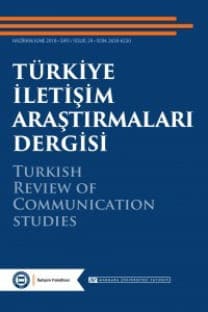Sanal Gerçeklik, Hakikat Kavramının Dönüşümü ve Popüler Kültürdeki Yansımaları
Gerçeklik, Sanal Gerçeklik, Arkhe, Teknoloji, Bilinç
Virtual Reality, Transformation of ‘Truth’, and The Subsequent Reflections on Popular Culture
Reality, Virtual Reality, Arche, Technology, Consciousness,
___
- Baudrillard, J. (2005). Oğuz A. (Çev.). Şeytana Satılan Ruh, Ankara: Doğubatı Yayınları.
- Bağlı, M. (2011). Modern Bilinç ve Mahremiyet, İstanbul: Yarın Yayınları.
- Blascovich J., Bailenson J. (2011). Infinite Reality, U.S.A.: Harper Collins E–Books.
- Cevizci, A. (2012). Felsefe Tarihi, İstanbul: Say Yayınları. Chalmers, D. J.. (2016). The Virtual and the Real. http://consc.net/ 02.02.2018 tarihinde http://consc.net/all-papers-by-date/ adresinden edinilmiştir.
- Chalmers, D. J.. (2003). The Matrix as Metaphysics. http://consc.net/ 02.02.2018 tarihinde http://consc.net/all-papers-by-date/ adresinden edinilmiştir.
- Cogburn, J. & Silcox, M. (2014). Against Brain-in-a-Vatism: On the Value of Virtual Reality. Philosophy & Technology. 561-579.
- Cresweel, J. W. (2016). M. Bütün., S. B. Demir (Çev.). Nitel Araştırma Yöntemleri, Beş Yaklaşıma Göre Nitel Araştırma ve Araştırma Deseni. Ankara: Siyasal Kitapevi.
- Descartes, R. (2013). A.Yardımlı (Çev.). İlk Felsefe Üzerine Meditasyonlar. İstanbul: İdea Yayınevi, 4. Baskı.
- Flanagan, V. (2014). Technology and Identity in Young Adult Fiction, The Posthuman Subject. U.K.,: Palgrave Macmillan Press.
- Geraci, R. (2010). Apocalyptic AI, Visions of Heaven in Robotics, Artificial Intelligence, and Virtual Reality. U.S.A: Oxford University Press.
- Grimshaw, M. (2014).(Ed.). The Oxford Handbook of Virtuality. U.SA: Oxford University Press.
- Hançerlioğlu, O. (1985). Felsefe Ansiklopedisi. Cilt 1,2,3,4, İstanbul: Remzi Kitabevi.
- Haraway, D. (2006). Siborg Manifestosu. İstanbul: Agora Kitaplığı.
- Heim, M. (1993). The Metaphysics of Virtual Reality. U.S.A: Oxford University Press.
- Işıklı, Ş., Küçükvardar, M. (2016). Bilişim Devrimi, Ankara: Birleşik Yayınevi.
- Kennedy, L. (2012). From Plato to Portal: 3000 Years of Virtual Reality. www. Virtualstudio.tv. 10.12.2017 tarihinde http://www.virtualstudio.tv/blog/post/134-from-plato-to-portal-3000-years-of-virtual-reality adresinden edinilmiştir.
- Kornelsen, J. (1991). Virtual Reality? Marshall Mc Luhan and a Phenomenological Investigation of the Construction of Virtual Worlds, Thesis Submitted in Partial Fulfillment of the Requirements For the Degree of Master of Arts. Canada: Simon Fraser University.
- Lenin, V.I. (2001). İ. Yarkın (Çev.). Materyalizm ve Ampriokritisizm. İstanbul: İnter Yayınları. “Matrix_(film)”. 06.06.2018 tarihinde https://tr.wikipedia.org/wiki/Matrix_(film) adresinden edinilmiştir.
- Mc Luhan, M. (2014). Gül Ç. G. (Çev.). Gutenberg Galaksisi, Tipografik İnsanın Oluşumu. Cogito İletişim. İstanbul: Yapı Kredi Yayınları.
- Meijsing, M. (2006). Real people and virtual bodies: How disembodied can embodiment be? Minds & Machines, (16) 443–461.
- Olshin, B. B. (2006). Reality Check: The Possible Detection of Simulated Environments through Observation of Selected Physical Phenomena, The University of Cape Coast Journal of Philosophy and Culture, 3 – 5.
- Politzer, G. (1997). M. Erdost (Çev.). Felsefenin Temel İlkeleri. İstanbul: Sol Yayınları, 14. Baskı.
- Platon. (2001). F. Akderin (Çev.). Devlet. İstanbul: Say Yayınları.
- “Ready Player One”. 11.07.2018 tarihinde https://www.imdb.com/title/tt1677720/ adresinden edinilmiştir.
- Render. https://tr.wikipedia.org. 11.04.2018 tarihinde https://tr.wikipedia.org/wiki/Render adresinden edinilmiştir.
- Rheingold, H. (2014). Quality, Innovation, and the Virtual World Art, Mind, Technology. Sex, Drugs and Tessellation_ The truth about Virtual Reality. U.S.A: CyberEdge Journal. 285-290.
- Sabah Ş. (2017). Ben, Kendim ve Avatarım: Sanallık ve Gerçeklik Arasında Tüketim, Sahip Olunanlar ve Kişisel Benlik. Tüketici ve Tüketim Araştırmaları Dergisi. (9) 1, 117-154.
- Seegert, A. (2014). Desert of the Real, Oasis of the Virtual: Technostalgic Pastoral in À Rebours and Ready Player One. https://www.academia.edu. 11.08.2018 tarihinde https://www.academia.edu/9332745/Desert_of_the_Real_Oasis_of_the_Virtual_Technostalgic_Pastoral_in_%C3%80_Rebours_and_Ready_Player_One adresinden edinilmiştir.
- Steinicke, F. (2016). Being Really Virtual, Immersive Natives and the Future of Virtual Reality, Germany: Springer International Publishing.
- Thalmann, N. M. (1994). Nadia Magnenat T. & Daniel T. (Ed.). Artificial Life and Virtual Reality. England: John Wiley & Son’s Ltd.
- Timisi, N. (2003). Yeni İletişim Teknolojileri ve Demokrasi. Ankara: Dost Yayınları.
- Timpanaro, S. (1997). Ayşegül Ertuğrul (Çev.). Materyalizm Üzerine Düşünceler. Teori ve Politika içinde (ss. 8-15). İstanbul: Teori ve Politika Dergisi.
- Turkle, S. (1994). Constructions and Reconstructions of Self in Virtual Reality: Playing in the MUDs. Mind Culture and Activity .(1) 3, 158 – 167.
- Turkle, S. (1996). Who Am We? https://www.wired.com/ 18.06.2018 tarihinde https://www.wired.com/1996/01/turkle-2/ adresinden edinilmiştir.
- Weberman, D. (2003). M. Sağlam (Çev.). Matrix Simülasyonu ve Postmodern Çağ, Matrix ve Felsefe içinde (ss. 262-277). İstanbul: Güncel Yayıncılık.
- Zizek, S. (2014). Bahadır T. (Çev.). Matrix, Sapkınlığın İki Yüzü. İstanbul: Encore Yayınları, 2. Baskı.
- Başlangıç: 1992
- Yayıncı: Marmara Üniversitesi
(MMO)RPG Video Oyun Karakterlerinin Cinsiyet ve Etnik Stereotipleri
Sanal Gerçeklik, Hakikat Kavramının Dönüşümü ve Popüler Kültürdeki Yansımaları
Bir Kamu Politikası Aracı Olarak Davranışsal İçgörü
Başkalarının Aşkı: Hangi Kadın Filminde Mimetik Arzu
Kış Uykusu’nu Kant ve Nietzsche Etiği Çerçevesinde Düşünmek
Burcu KAYA ERDEM, Elif KARAKOÇ
İlkokul Öğrencilerinin Çizgi Film İzleme Pratikleri ve Çizgi Film Karakterlerine İlişkin Algıları
Reklamda Egemen İdeolojiyi Çözümlemek: Cinsiyet Rolleri ve Fanatizm Okuması
